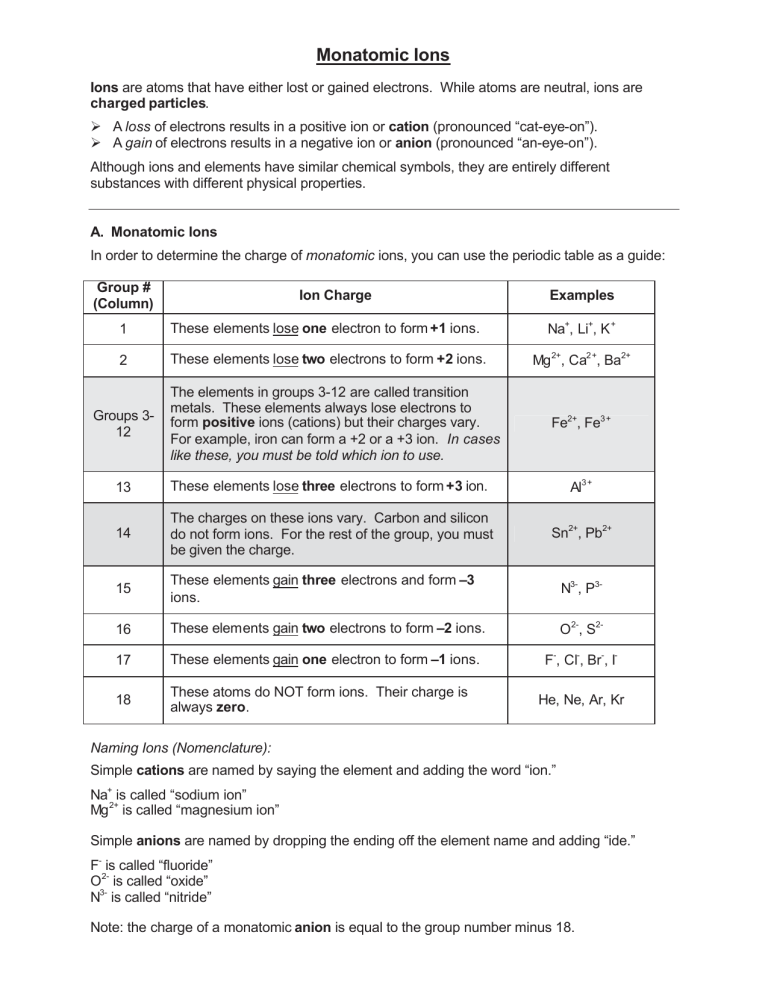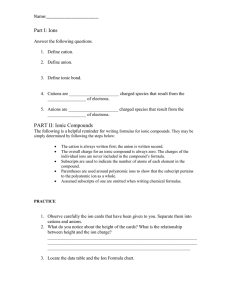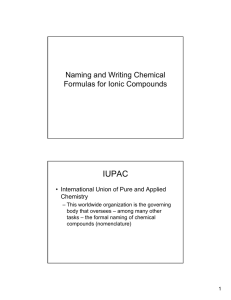
Monatomic Ions Ions are atoms that have either lost or gained electrons. While atoms are neutral, ions are charged particles. ¾ A loss of electrons results in a positive ion or cation (pronounced “cat-eye-on”). ¾ A gain of electrons results in a negative ion or anion (pronounced “an-eye-on”). Although ions and elements have similar chemical symbols, they are entirely different substances with different physical properties. A. Monatomic Ions In order to determine the charge of monatomic ions, you can use the periodic table as a guide: Group # (Column) Ion Charge Examples 1 These elements lose one electron to form +1 ions. Na+, Li+, K + 2 These elements lose two electrons to form +2 ions. Mg 2+, Ca2+, Ba2+ Groups 312 The elements in groups 3-12 are called transition metals. These elements always lose electrons to form positive ions (cations) but their charges vary. For example, iron can form a +2 or a +3 ion. In cases like these, you must be told which ion to use. Fe2+, Fe3+ 13 These elements lose three electrons to form +3 ion. Al3+ 14 The charges on these ions vary. Carbon and silicon do not form ions. For the rest of the group, you must be given the charge. Sn2+, Pb2+ 15 These elements gain three electrons and form –3 ions. N3-, P3- 16 These elements gain two electrons to form –2 ions. O2-, S2- 17 These elements gain one electron to form –1 ions. F-, Cl-, Br-, I- 18 These atoms do NOT form ions. Their charge is always zero. He, Ne, Ar, Kr Naming Ions (Nomenclature): Simple cations are named by saying the element and adding the word “ion.” Na+ is called “sodium ion” Mg 2+ is called “magnesium ion” Simple anions are named by dropping the ending off the element name and adding “ide.” F- is called “fluoride” O2- is called “oxide” N3- is called “nitride” Note: the charge of a monatomic anion is equal to the group number minus 18. Nomenclature Worksheet 1: Monatomic Ions Use a periodic table to complete the table below: Element Name 1. sodium 2. bromine 3. magnesium 4. chlorine 5. oxygen 6. boron 7. lithium 8. neon 9. phosphorus 10.aluminum 11.calcium 12.iodine 13.nitrogen 14.cesium 15.sulfur 16.fluorine 17.potassium 18.barium 19.hydrogen 20.helium Element Symbol Ion Name Ion Formula Simple Binary Ionic Compounds Ionic compounds are compounds formed by the combination of a cation and a anion. (Think: “metal plus nonmetal”). Ionic compounds are more commonly known as “salts.” Binary ionic compounds are compounds containing only two elements, as demonstrated in the examples below. When writing formulas for ionic compounds, we use subscripts to indicate how many of each atom is contained in the compound. Remember that even though ions have charges, ionic compounds must be neutral. Therefore, the charges on the cation and the anion must cancel each other out. In other words, the net charge of an ionic compound equals zero. Example 1: For a salt containing sodium ion, Na+, and chloride, Cl-, the ratio is one to one. The positive charge on the sodium ion cancels out the negative charge on the chloride. (+1) + (-1) = 0 Therefore, the formula for the salt is NaCl. (The actual formula is Na 1Cl1, but chemists omit subscripts of 1). Example 2: For a salt containing calcium ion, Ca2+, and chloride, Cl-, the ratio can’t be one to one. (+2) + (-1) = +1 Remember that ionic compounds must be neutral. In order to yield a neutral compound, two chlorides must bond to the calcium ion: (+2) + 2(-1) = 0 So, the formula for this salt is CaCl2. Nomenclature: When naming ionic compounds, simply write the element name of the metal followed by the ion name of the nonmetal. (Remember: the metal ion (cation) is always written first!) NaCl is called “sodium chloride,” and CaCl2 is called “calcium chloride.” Nomenclature Worksheet 2: Simple Binary Ionic Compounds Please complete the following table: Name of Ionic Compound Formula of Ionic Compound 1. Sodium bromide 2. Calcium chloride 3. Magnesium sulfide 4. Aluminum oxide 5. Lithium phosphide 6. Cesium nitride 7. Potassium iodide 8. Barium fluoride 9. Rubidium nitride 10.Barium oxide 11. K2O 12. MgI2 13. AlCl3 14. CaBr2 15. Na3N 16. LiF 17. Ba3P2 18. Cs2S 19. SrF 2 20. NaCl


